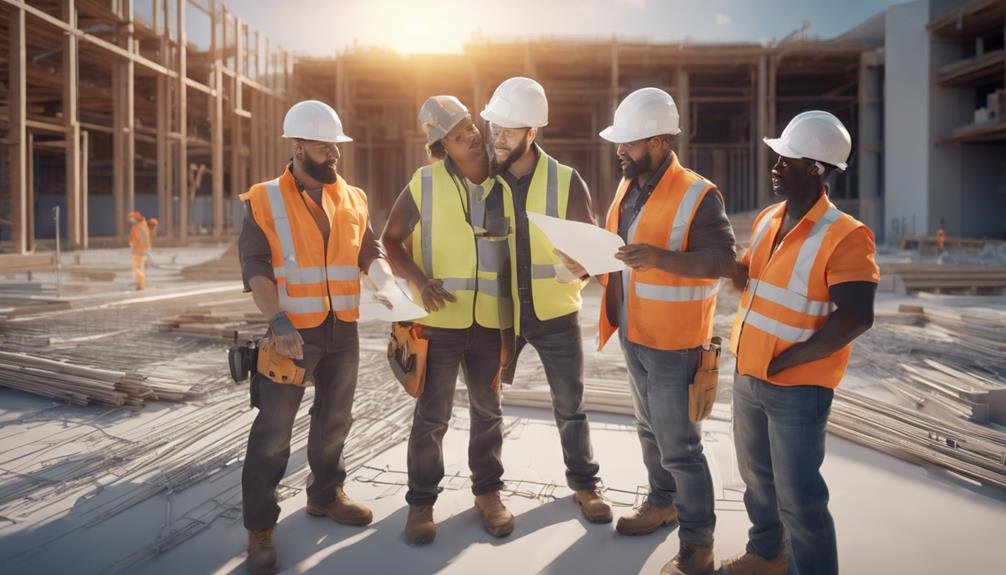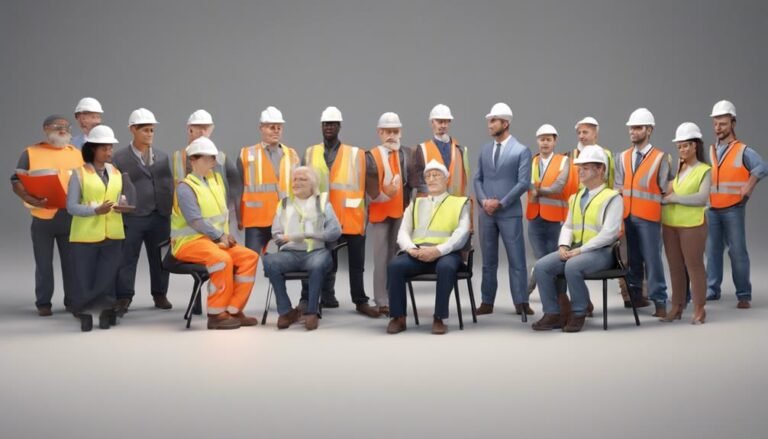Navigating Team Dynamics on Large Construction Projects
To navigate team dynamics on large construction projects, start by ensuring role clarity to enhance cohesion. Set clear expectations and milestones to prevent confusion and track progress effectively. Establish transparent communication channels and hold regular progress meetings for updates. Utilize conflict resolution techniques like active listening and mediation for smoother discussions. Build trust through team activities and communication training. Manage diverse perspectives by promoting empathy and cultural understanding. Leverage technology tools such as BIM and project management software. Promote accountability and celebrate team successes to foster a positive work environment. These strategies are essential for optimizing team performance and project outcomes.
Key Takeaways
- Clear role assignments prevent confusion and overlap, enhancing collaboration.
- Transparent communication fosters teamwork and project efficiency.
- Regular progress review meetings aid in updates and suggestions.
- Utilize project management software for effective task tracking.
- Establish communication protocols for streamlined information flow.
Understanding Team Roles
To effectively navigate team dynamics on large construction projects, understanding the specific roles each team member plays is essential for success. Role clarity is vital for ensuring that everyone knows their responsibilities and how they contribute to the overall project.
Team dynamics rely heavily on team cohesion, a factor that's directly influenced by how well each team member understands and executes their role. When roles are clearly defined, it becomes easier to identify areas for improvement and conduct performance analysis to enhance overall team effectiveness.
Setting Clear Expectations
To guarantee smooth team dynamics on large construction projects, you must establish clear role assignments to prevent confusion and overlap.
Utilize transparent communication channels so that information flows efficiently among team members, fostering collaboration and understanding.
Define project milestones clearly to provide a roadmap for progress, ensuring everyone is aligned and working towards the same goals.
Clear Role Assignments
Clear role assignments are crucial in guaranteeing that team members understand their responsibilities and expectations on large construction projects. When roles are clearly defined, it enhances team collaboration and ensures role clarity, leading to smoother project execution. By assigning specific tasks to each team member, you reduce confusion, duplication of efforts, and conflicts. Below is an example of how role assignments can be structured to guarantee clarity and efficiency:
| Role | Responsibilities |
|---|---|
| Project Manager | Oversees the entire project and team members |
| Site Engineer | Manages on-site activities and coordinates workers |
| Architect | Designs project plans and communicates with clients |
| Construction Crew | Executes construction tasks according to plans |
Transparent Communication Channels
How can you guarantee that transparent communication channels are established to set clear expectations in large construction projects?
Open dialogue and honest feedback are key components in fostering transparent communication. Encourage team members to express their thoughts openly and provide feedback constructively.
Implement transparent updates to keep everyone informed about project progress, challenges, and changes. Regular check-ins ensure that expectations are aligned and any issues are addressed promptly.
Defined Project Milestones
Establishing defined project milestones is essential for setting clear expectations in large construction projects. Milestone tracking allows you to break down the project into smaller, manageable segments, making progress monitoring more effective. By setting specific milestones, you provide a roadmap for your team, ensuring everyone is aligned on the project's timeline and objectives. This clarity helps in identifying potential delays or issues early on, allowing for timely adjustments to keep the project on track. Additionally, milestones serve as checkpoints for evaluating the project's progress and can be pivotal in demonstrating achievements to stakeholders. Effective milestone tracking and progress monitoring are key components in ensuring the successful and timely completion of large construction projects.
| Benefits of Defined Project Milestones | ||
|---|---|---|
| Break down project into manageable segments | Align team on timeline and objectives | Identify delays or issues early on |
Effective Communication Strategies
To ensure effective communication on large construction projects, it's crucial to establish clear channels for information flow and feedback among all team members. Improved feedback mechanisms can be implemented by setting up regular progress review meetings where team members can share updates, concerns, and suggestions. Utilizing project management software can also facilitate efficient updates by providing a centralized platform for communication, document sharing, and task tracking.
Additionally, establishing a communication protocol outlining preferred methods of communication, response times, and escalation procedures can help streamline information dissemination.
Another effective strategy is to encourage open and transparent communication among team members. This can be achieved by fostering a culture where individuals feel comfortable expressing their ideas and concerns without fear of judgment. Implementing regular check-ins or stand-up meetings can provide opportunities for team members to discuss progress, obstacles, and potential solutions collaboratively.
Conflict Resolution Techniques
You need to master active listening skills, employ mediation strategies, and engage in collaborative problem-solving when managing conflict on large construction projects.
By actively listening to all parties involved, you can make certain that each perspective is heard and understood.
Mediation techniques can help facilitate discussions and find mutually beneficial solutions, while collaborative problem-solving fosters teamwork and innovation in resolving conflicts.
Active Listening Skills
Practicing active listening is essential for effectively resolving conflicts in team dynamics on large construction projects. Improving communication through active listening allows team members to feel heard and understood, which fosters trust and promotes a collaborative environment.
When engaging in active listening, focus on the speaker without interruptions, maintain eye contact, and provide feedback to demonstrate understanding. Reflecting on what's being said and asking clarifying questions can help prevent misunderstandings and miscommunications.
Mediation Strategies
Implementing effective mediation strategies is vital for managing and resolving conflicts within construction project teams. Conflict resolution plays a significant role in maintaining team dynamics and ensuring project success.
Communication strategies are key to addressing issues promptly and fostering team cohesion. When conflicts arise, it's important to encourage open communication among team members to understand different perspectives and find common ground.
Active listening skills are valuable during mediation sessions to show empathy and build trust. Setting ground rules for discussions and ensuring a neutral mediator can help facilitate productive conversations.
Collaborative Problem-Solving
Crafting collaborative problem-solving approaches is essential for resolving conflicts effectively within construction project teams.
Team problem solving involves bringing together diverse perspectives and experiences to tackle complex issues. Collaborative teamwork fosters a supportive environment where team members feel valued and heard.
To enhance collaborative problem-solving, encourage open communication and active listening among team members. Establish a structured process for identifying, analyzing, and resolving conflicts promptly. Utilize tools like brainstorming sessions, root cause analysis, and consensus-building techniques to reach mutually beneficial solutions.
Building Trust and Collaboration
Building trust and fostering collaboration among team members is fundamental for the success of large construction projects. Trust building exercises, collaborative workshops, team bonding activities, and communication training are essential components in establishing a cohesive and efficient team. By investing time and resources into these initiatives, you can create a work environment where team members feel valued, respected, and motivated to work towards a common goal.
| Trust Building Exercises | Collaborative Workshops | Team Bonding Activities |
|---|---|---|
| Role-playing scenarios | Problem-solving tasks | Outdoor team-building |
| Open communication sessions | Brainstorming sessions | Social gatherings |
Trust building exercises like role-playing scenarios can help team members understand each other's perspectives and build empathy. Collaborative workshops, such as problem-solving tasks, can enhance problem-solving skills and encourage teamwork. Team bonding activities, like outdoor team-building exercises, can strengthen relationships and foster a sense of unity among team members. By incorporating these strategies into your project management approach, you can lay a solid foundation for trust and collaboration within your construction team.
Managing Diverse Perspectives
How can you effectively navigate and address diverse perspectives within your construction project team to guarantee efficient communication and collaboration?
To manage diverse perspectives, consider implementing empathy training and cultural sensitivity workshops. These initiatives can help team members understand and respect each other's backgrounds and viewpoints, fostering a more inclusive and harmonious work environment.
In addition, promote inclusive decision-making processes where every team member has the opportunity to contribute ideas and opinions. By valuing and integrating diverse perspectives into the decision-making process, you can enhance creativity and problem-solving within the team.
Conflict resolution techniques are essential for addressing disagreements that may arise due to differing perspectives. Equip team members with effective conflict resolution skills to navigate conflicts constructively and maintain a positive team dynamic.
Leveraging Technology Tools
To optimize project efficiency and communication, leverage various technology tools tailored to streamline processes and enhance collaboration within your construction project team. Technology integration plays an important role in modern construction projects. By implementing digital collaboration platforms, you can guarantee real-time updates and seamless communication among team members, regardless of their physical location. These tools not only enhance efficiency but also promote transparency and accountability within the team.
Consider the following table showcasing some key technology tools that can revolutionize the way your construction team operates:
| Technology Tool | Functionality |
|---|---|
| Building Information | Centralized platform for storing and |
| Modeling (BIM) | managing project-related information. |
| Project Management | Task assignment, scheduling, and tracking |
| Software | of progress. |
| Drones | Aerial monitoring of construction sites |
| for progress updates and safety assessments. | |
| Virtual Reality (VR) | Immersive simulations for design reviews |
| and client presentations. |
Integrating these tools into your workflow can greatly boost project efficiency and collaboration, ultimately leading to successful project outcomes.
Promoting Accountability
Promoting accountability within your construction team requires clear delineation of roles and responsibilities from the project's outset. Fostering ownership among team members is vital to make sure everyone feels responsible for their tasks. By clearly defining who's in charge of what, you enhance transparency and minimize confusion. Encourage open communication channels so that team members feel comfortable discussing progress and setbacks.
Driving accountability is essential for improving performance. Set clear goals and deadlines, and regularly follow up on progress. Holding individuals accountable for their contributions motivates them to meet expectations and deliver quality work. Implementing regular check-ins and performance reviews can help track accountability and address any issues promptly.
To promote accountability effectively, create a culture where taking ownership of tasks is celebrated and recognized. When team members feel responsible for their work and see the impact of their contributions, they're more likely to stay committed and aim for excellence. Ultimately, driving accountability leads to improved performance and successful project outcomes.
Celebrating Team Successes
Recognize team achievements by organizing regular celebrations to foster a positive and motivated work environment. Team recognition is a key component in boosting motivation and morale. By appreciating contributions and rewarding outstanding performance, you not only acknowledge individual efforts but also strengthen the team dynamic. Consider hosting monthly or quarterly gatherings where accomplishments are highlighted, and team members are praised for their hard work. This could involve acknowledging milestones reached, successful project completions, or even personal achievements of team members.
In these celebrations, make sure to provide tangible rewards such as gift cards, certificates of appreciation, or small tokens of gratitude. These gestures go a long way in showing that the team's efforts are valued and recognized. Additionally, creating a positive atmosphere through these events can lead to increased job satisfaction and a sense of belonging within the team.
Conclusion
To sum up, managing team dynamics on large construction projects requires a strategic approach. By understanding team roles, setting clear expectations, and promoting effective communication, conflict resolution, trust, and collaboration, you can guarantee project success.
Remember, celebrating team successes is key to maintaining morale and motivation. So, stay organized, embrace diverse perspectives, leverage technology tools, and hold each other accountable.
With these strategies in place, your team can overcome any challenge and achieve great things together.







